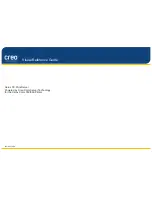
5-2
Cisco UCS Invicta C3124SA Appliance Administration Guide
OL-25761-DRAFT
Chapter 5 Asynchronous Replication
–
Increase in size
–
Delete operation
Note
The first replication that is performed on a pairing is always a FULL replication. Subsequent replications
reflect the delta, except where an “Update Partner” operation is performed. In that case, the immediate
next replication would become a FULL replication.
Communicating with a Partner Host
To perform replication successfully, there must be a way for communicating between the local LUN and
the remote replication site to establish that the client (local Cisco Array) is allowed to invoke commands
on the server (remote replication site).
The Cisco Array uses the standard remote shell facility, ssh, leveraging on password-less access after
putting its public key to the proper location at the remote replication site.
For LUNs, Cisco supports open-target Async Replication. It can duplicate to the following platforms:
•
Cisco Array
•
Linux systems:
–
Linux-LVM
–
Linux-RAW
•
Windows 2008 R2 or later Server editions.
Table 5.1 lists the releases that are supported for LUNS. Instructions for each platform follow:
Cisco to Cisco
Cisco-to-Cisco Async Replication is preconfigured and is complete. To create a pairing, see
Create a
Pairing, page 5-6
.
”
Cisco to Linux-LVM
Step 1
Click
Public Key
to obtain the public key necessary for using password-less ssh access.
Table 5-1
Supported Releases
Platform
Supported Releases
Additional Information
Cisco
Cisco UCS Invicta OS >= 4.1.1
Destination LUN needs to be a LUN of the
same size as the source LUN.
Linux-LVM
Kernel version >= 2.6.3
LVM2 version >= 2.02
Destination target needs to be a logical
volume of the same size as the source LUN.
Linux-RAW
Kernel version >= 2.6.3
Destination block device needs to be the
same size as the source LUN.
Windows
Windows 2008 R2 or later Server
editions
Duplicates directly to a file.















































